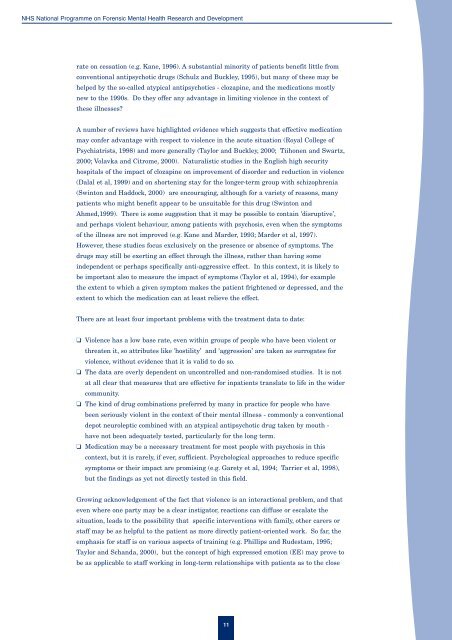Mental Illness and Serious Harm to Others - University of Liverpool
Mental Illness and Serious Harm to Others - University of Liverpool
Mental Illness and Serious Harm to Others - University of Liverpool
You also want an ePaper? Increase the reach of your titles
YUMPU automatically turns print PDFs into web optimized ePapers that Google loves.
NHS National Programme on Forensic <strong>Mental</strong> Health Research <strong>and</strong> Development<br />
rate on cessation (e.g. Kane, 1996). A substantial minority <strong>of</strong> patients benefit little from<br />
conventional antipsychotic drugs (Schulz <strong>and</strong> Buckley, 1995), but many <strong>of</strong> these may be<br />
helped by the so-called atypical antipsychotics - clozapine, <strong>and</strong> the medications mostly<br />
new <strong>to</strong> the 1990s. Do they <strong>of</strong>fer any advantage in limiting violence in the context <strong>of</strong><br />
these illnesses?<br />
A number <strong>of</strong> reviews have highlighted evidence which suggests that effective medication<br />
may confer advantage with respect <strong>to</strong> violence in the acute situation (Royal College <strong>of</strong><br />
Psychiatrists, 1998) <strong>and</strong> more generally (Taylor <strong>and</strong> Buckley, 2000; Tiihonen <strong>and</strong> Swartz,<br />
2000; Volavka <strong>and</strong> Citrome, 2000). Naturalistic studies in the English high security<br />
hospitals <strong>of</strong> the impact <strong>of</strong> clozapine on improvement <strong>of</strong> disorder <strong>and</strong> reduction in violence<br />
(Dalal et al, 1999) <strong>and</strong> on shortening stay for the longer-term group with schizophrenia<br />
(Swin<strong>to</strong>n <strong>and</strong> Haddock, 2000) are encouraging, although for a variety <strong>of</strong> reasons, many<br />
patients who might benefit appear <strong>to</strong> be unsuitable for this drug (Swin<strong>to</strong>n <strong>and</strong><br />
Ahmed,1999). There is some suggestion that it may be possible <strong>to</strong> contain 'disruptive’,<br />
<strong>and</strong> perhaps violent behaviour, among patients with psychosis, even when the symp<strong>to</strong>ms<br />
<strong>of</strong> the illness are not improved (e.g. Kane <strong>and</strong> Marder, 1993; Marder et al, 1997).<br />
However, these studies focus exclusively on the presence or absence <strong>of</strong> symp<strong>to</strong>ms. The<br />
drugs may still be exerting an effect through the illness, rather than having some<br />
independent or perhaps specifically anti-aggressive effect. In this context, it is likely <strong>to</strong><br />
be important also <strong>to</strong> measure the impact <strong>of</strong> symp<strong>to</strong>ms (Taylor et al, 1994), for example<br />
the extent <strong>to</strong> which a given symp<strong>to</strong>m makes the patient frightened or depressed, <strong>and</strong> the<br />
extent <strong>to</strong> which the medication can at least relieve the effect.<br />
There are at least four important problems with the treatment data <strong>to</strong> date:<br />
❑ Violence has a low base rate, even within groups <strong>of</strong> people who have been violent or<br />
threaten it, so attributes like 'hostility’ <strong>and</strong> 'aggression’ are taken as surrogates for<br />
violence, without evidence that it is valid <strong>to</strong> do so.<br />
❑ The data are overly dependent on uncontrolled <strong>and</strong> non-r<strong>and</strong>omised studies. It is not<br />
at all clear that measures that are effective for inpatients translate <strong>to</strong> life in the wider<br />
community.<br />
❑ The kind <strong>of</strong> drug combinations preferred by many in practice for people who have<br />
been seriously violent in the context <strong>of</strong> their mental illness - commonly a conventional<br />
depot neuroleptic combined with an atypical antipsychotic drug taken by mouth -<br />
have not been adequately tested, particularly for the long term.<br />
❑ Medication may be a necessary treatment for most people with psychosis in this<br />
context, but it is rarely, if ever, sufficient. Psychological approaches <strong>to</strong> reduce specific<br />
symp<strong>to</strong>ms or their impact are promising (e.g. Garety et al, 1994; Tarrier et al, 1998),<br />
but the findings as yet not directly tested in this field.<br />
Growing acknowledgement <strong>of</strong> the fact that violence is an interactional problem, <strong>and</strong> that<br />
even where one party may be a clear instiga<strong>to</strong>r, reactions can diffuse or escalate the<br />
situation, leads <strong>to</strong> the possibility that specific interventions with family, other carers or<br />
staff may be as helpful <strong>to</strong> the patient as more directly patient-oriented work. So far, the<br />
emphasis for staff is on various aspects <strong>of</strong> training (e.g. Phillips <strong>and</strong> Rudestam, 1995;<br />
Taylor <strong>and</strong> Sch<strong>and</strong>a, 2000), but the concept <strong>of</strong> high expressed emotion (EE) may prove <strong>to</strong><br />
be as applicable <strong>to</strong> staff working in long-term relationships with patients as <strong>to</strong> the close<br />
11
















